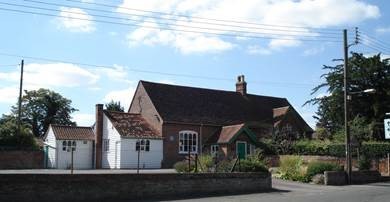About Aylett's Building
The building the library and museum are situated in originates from around 1630 and has a very interesting life serving the villagers in many ways, but its main role has been that of a school.
Thomas Aylett built the school and endowed it in his will in 1637. Within a couple of decades, it was used to accommodate the Cromwellian cavalry. An enquiry in 1739 found that the school house "ruinous and unsafe, without seat or flooring, windows and roof ready to fall in". The date of the restoration is still visible on a wall inside the library.
With the death of schoolmaster John Fuller, the school closed in 1842. Led by the Minister of the Congregational Chapel, a committee succeeded in re-establishing it as The British School in 1846. John Orst - a smallholder, seed grower and part time accountant - took on the post of Schoolmaster and markedly raised the standards of discipline and education. It became necessary to add a room for infants (now the main museum room) in 1886. From 1902 to 1944, the school operated as a Non-Provided School under dual control of local managers and the County Authority.
When it was again occupied by troops in the First World War, lessons temporarily transferred to the Quaker Meeting House on the High Street in Kelvedon. Its most famous teacher arrived in 1919 - this was the innovative Helen Corke, confidante of DH Lawrence, who instituted a school badge, uniform, physical education and outings.
Lessons here ceased in 1944, but the building continued to serve as a school canteen for St Mary's Primary School (then in Easterford Road) until the new school was built in 1969.
The local branch of the County Library transferred here from St Mary's Hall in June 1970, to be joined by the fledgling museum five years later.
About the Feering & Kelvedon Local History Museum
Formed in 1975, the museum is governed by a committee of six or more including four Trustees and two officers, a Chairman, Secretary and Treasurer and is served by between 15 and 20 voluntary Stewards who between them assist with research enquiries and the indexation, display and storage of donated artefacts, documents and information.
Some of the committee members have also produced publications relating to local historical interests and you will find copies of many of these for sale in the museum.
The museum is financially supported by the Parish Councils of Feering and Kelvedon and by your donations and purchases. We do not charge for admission and, with your help, we hope we can continue to avoid such charges.
How can I contribute towards the Museum's work?
If you are a local resident, you could consider joining the body of Stewards who run the museum on a rota, covering three hour duties on Mondays or Saturdays several times a year.
We also welcome you to make contact if you have skills in the development of new exhibitions or the repair of artefacts, or if you have an interest in local history topics that can be met by taking up a research project.
If you would like to get involved, please contact us or talk to the Steward on duty when you next visit the museum.
